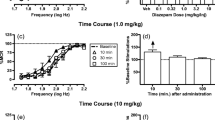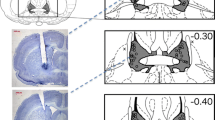Abstract
Rationale
Many monoamine releasers are abused by humans and produce abuse-related facilitation of intracranial self-stimulation (ICSS) in rats. Facilitation of ICSS in rats can be limited by monoamine releaser-induced serotonin (5-HT) release, but receptors that mediate 5-HT effects of monoamine releasers are unknown.
Objectives
The aim of this study is to investigate whether 5-HT2C receptor activation is necessary for rate-decreasing effects produced in an ICSS procedure in rats by the 5-HT-selective monoamine releaser fenfluramine and the non-selective releasers napthylisopropylamine (PAL-287) and (+)-3,4-methylenedioxymethamphetamine ((+)-MDMA).
Methods
Adult male Sprague-Dawley rats with electrodes implanted in the medial forebrain bundle were trained to lever press for brain stimulation under a “frequency-rate” ICSS procedure. Effectiveness of the 5-HT2C antagonist SB 242,084 was evaluated to block rate-decreasing effects produced by (1) the 5-HT2C agonist Ro 60-0175, (2) the 5-HT-selective releaser fenfluramine, and (3) the mixed-action dopamine (DA)/norepinephrine (NE)/5-HT releasers PAL-287 (1.0–5.6 mg/kg) and (+)-MDMA (1.0–3.2 mg/kg). For comparison, effectiveness of SB 242,084 to alter rate-decreasing effects of the kappa-opioid receptor agonist U69,593 and rate-increasing effects of the DA>5-HT releaser amphetamine was also examined.
Results
SB 242,084 pretreatment blocked rate-decreasing effects of Ro 60-0175 and fenfluramine, but not the rate-decreasing effects of U69,593 or the rate-increasing effects of amphetamine. SB 242,084 blunted the rate-decreasing effects and enhanced expression of rate-increasing effects of PAL-287 and (+)-MDMA.
Conclusions
These data suggest that 5-HT2C receptor activation contributes to rate-decreasing effects that are produced by selective and mixed-action 5-HT releasers in rats and that may oppose and limit the expression of abuse-related ICSS facilitation by these compounds.




Similar content being viewed by others
References
Alex KD, Pehek EA (2007) Pharmacologic mechanisms of serotonergic regulation of dopamine neurotransmission. Pharmacol Ther 113(2):296–320
Alex KD, Yavanian GJ, McFarlane HG, Pluto CP, Pehek EA (2005) Modulation of dopamine release by striatal 5HT2C receptors. Synapse 55(4):242–251
Battaglia G, De Souza EB (1989) Pharmacologic profile of amphetamine derivatives at various brain recognition sites: selective effects on serotonergic systems. NIDA Res Monogr Ser 94:240–258
Bauer CT, Banks ML, Blough BE, Negus SS (2013) Use of intracranial self-stimulation to evaluate abuse-related and abuse-limiting effects of monoamine releasers in rats. Br J Pharmacol 168(4):850–862
Baumann MH, Clark RD, Woolverton WL, Wee S, Blough BE, Rothman RB (2011) In vivo effects of amphetamine analogs reveal evidence for serotonergic inhibition of mesolimbic dopamine transmission in the rat. J Pharmacol Exp Ther 337(1):218–225
Baumann MH, Ayestas MA, Partilla JS, Sink JR, Shulgin AT, Daley PF, Brandt SD, Rothman RB, Buoho AE, Cozzi NV (2012) The designer methcathinone analogs, mephedrone and methylone, are substrates for monoamine transporters in brain tissue. Neuropsychopharmacology 37:1192–1203
Bonano JS, Banks ML, Kolanos R, Sakloth F, Barnier ML, Glennon RA, Cozzi NV, Partilla JS, Baumann MH, Negus SS (2015) Quantitative structure-activity relationship analysis of the pharmacology of para-substituted methcathinone analogs. Br J Pharmacol 172:2433–2444
Bradbury S, Bird J, Colussi-Mas J, Mueller M, Ricaurte G, Schenk S (2014) Acquisition of MDMA self-administration: pharmacokinetic factors and MDMA-induced serotonin release. Addict Biol 19(5):874–884
Bubar MJ, Cunningham KA (2008) Prospects for 5-HT2R pharmacotherapy in psychostimulant abuse. Prog Brain Res 172:319–346
Cathala A, Devroye C, Maitre M, Piazza PV, Abrous DN, Revest JM, Spampinato U (2014) Serotonin2C receptors modulate dopamine transmission in the nucleus accumbens independently of dopamine release: behavioral, neurochemical and molecular studies with cocaine. Addict Biol. doi:10.1111/adb.12137
Di Giovanni G, De Deurwaerdere P, Di Mascio M, Di Matteo V, Esposito E, Spampinato U (1999) Selective blockade of serotonin-2C/2B receptors enhances mesolimbic and mesostriatal dopaminergic function: a combined in vivo electrophysiological and microdialysis study. Neuroscience 91:587–597
Di Giovanni G, Di Matteo V, Di Mascio M, Esposito E (2000) Preferential modulation of mesolimbic vs. nigrostriatal dopaminergic function by serotonin(2C/2B) receptor agonists: a combined in vivo electrophysiological and microdialysis study. Synapse 35(1):53–61
Di Matteo V, Di Giovanni G, Di Mascio M, Esposito E (2000) Biochemical and electrophysiological evidence that RO 60-0175 inhibits mesolimbic dopaminergic function through serotonin(2C) receptors. Brain Res 865(1):85–90
Eberle-Wang K, Mikeladze Z, Uryu K, Chesselet MF (1997) Pattern of expression of the serotonin2C receptor messenger RNA in the basal ganglia of adult rats. J Comp Neurol 384(2):233–247
Fletcher PJ, Chintoh AF, Sinyard J, Higgins GA (2004) Injection of the 5-HT2C receptor agonist Ro60-0175 into the ventral tegmental area reduces cocaine-induced locomotor activity and cocaine self-administration. Neuropsychopharmacology 29(2):308–318
Götestam KG, Andersson BE (1975) Self-administration of amphetamine analogues in rats. Pharmacol Biochem Behav 3(2):229–233
Grottick AJ, Fletcher PJ, Higgins GA (2000) Studies to investigate the role of 5HT(2C) receptors on cocaine- and food-maintained behavior. J Pharmacol Exp Ther 295(3):1183–1191
Hayes DJ, Clements R, Greenshaw AJ (2009a) Effects of systemic and intra-nucleus accumbens 5HT2C receptor compounds on ventral tegmental area self-stimulation thresholds in rats. Psychopharmacology (Berl) 203(3):579–588
Hayes DJ, Mosher TM, Greenshaw AJ (2009b) Differential effects of 5HT2C receptor activation by WAY 161503 on nicotine-induced place conditioning and locomotor activity in rats. Behav Brain Res 197(2):323–330
Higgins GA, Silenieks LB, Robmann A, Rizos Z, Noble K, Soko AD, Fletcher PJ (2012) The 5-HT2C receptor agonist lorcaserin reduces nicotine self-administration, discrimination, and reinstatement: relationship to feeding behavior and impulse control. Neuropsychopharmacology 37:1177–1191
Howell LL, Cunningham KA (2015) Serotonin 5-HT2 receptor interactions with dopamine function: implications for therapeutics in cocaine use disorder. Pharmacol Rev 67:176–197
Johnston LD, O’Malley PM, Bachman JG, Schulenberg JE (2009) Monitoring the future. National results on adolescent drug use: overview of key findings, 2008 (NIH Publication No. 09-7401). National Institute on Drug Abuse, Bethesda
Katsidoni V, Apazoglou K, Panagis G (2011) Role of serotonin 5HT2A and 5HT2C receptors on brain stimulation reward and the reward-facilitating effect of cocaine. Psychopharmacology (Berl) 213(2-3):337–354
Lin HQ, Jackson DM, Atrens DM, Christie MJ, McGregor IS (1997) Serotonergic modulation of 3,4-methylenedioxymethamphetamine (MDMA)-elicited reduction of response rate but not rewarding threshold in accumbal self-stimulation. Brain Res 744(2):351–357
Manvich DF, Kimmel HL, Howell LL (2012a) Effects of serotonin 2C receptor agonists on the behavioral and neurochemical effects of cocaine in squirrel monkeys. J Pharmacol Exp Ther 341(2):424–434
Manvich DF, Kimmel HL, Cooper DA, Howell LL (2012b) The serotonin 2C receptor antagonist SB 242084 exhibits abuse-related effects typical of stimulants in squirrel monkeys. J Pharmacol Exp Ther 342(3):761–769
Mosher TM, Smith JG, Greenshaw AJ (2006) Aversive stimulus properties of the 5HT2C receptor agonist WAY 161503 in rats. Neuropharmacology 51(3):641–650
National Research Council (2011) Guide for the care and use of laboratory animals (8th edition). National Academies, Washington DC
Negus SS, Miller LL (2014) Intracranial self-stimulation to evaluate abuse potential of drugs. Pharmacol Rev 66(3):869–917
Negus SS, Morrissey EM, Rosenberg M, Cheng K, Rice KC (2010) Effects of kappa opioids in an assay of pain-depressed intracranial self-stimulation in rats. Psychopharmacology (Berl) 210(2):149–159
Olds ME (1995) Dopamine agonists prevent or counteract the suppression of brain stimulation reward by fenfluramine. Pharmacol Biochem Behav 50(1):41–48
Olds ME, Yuwiler A (1992) Effects of acute and chronic fenfluramine on self-stimulation and its facilitation by amphetamine. Eur J Pharmacol 216(3):363–372
Parada M, Hernandez L, Schwartz D, Hoebel BG (1988) Hypothalamic infusion of amphetamine increases serotonin, dopamine and norepinephrine. Physiol Behav 44(4-5):607–610
Paxinos G, Watson C (1998) The rat brain in stereotaxic coordinates. Academic, San Diego
Pompeiano M, Palacios JM, Mengod G (1994) Distribution of the serotonin 5-HT2 receptor family mRNAs: comparison between 5-HT2A and 5-HT2C receptors. Mol Brain Res 23(1):163–178
Rothman RB, Baumann MH (2006) Balance between dopamine and serotonin release modulates behavioral effects of amphetamine-type drugs. Ann N Y Acad Sci 1074:245–260
Rothman RB, Baumann MH, Dersch CM, Romero DV, Rice KC, Carroll FI, Partilla JS (2001) Amphetamine-type central nervous system stimulants release norepinephrine more potently than they release dopamine and serotonin. Synapse 39(1):32–41
Setola V, Hufeisen SJ, Grande-Allen KJ, Vesely I, Glennon RA, Blough B, Rothman RB, Roth BL (2003) 3,4-methylenedioxymethamphetamine (MDMA, “Ecstasy”) induces fenfluramine-like proliferative actions on human cardiac valvular interstitial cells in vitro. Mol Pharmacol 63(6):1223–1229
Sulzer D (2011) How addictive drugs disrupt presynaptic dopamine neurotransmission. Neuron 69:628–649
Wee S, Woolverton WL (2006) Self-administration of mixtures of fenfluramine and amphetamine by rhesus monkeys. Pharmacol Biochem Behav 84:337–343
Wee S, Anderson KG, Baumann MH, Rothman RB, Blough BE, Woolverton WL (2005) Relationship between the serotonergic activity and reinforcing effects of a series of amphetamine analogs. J Pharmacol Exp Ther 313(2):848–854
Woods JH, Tessel RE (1974) Fenfluramine: amphetamine congener that fails to maintain drug-taking behavior in the rhesus monkey. Science 185(4156):1067–1069
Acknowledgments
These studies were supported by the National Institute of Health grants F30DA034478 (CTB), R01-DA033930 (SSN), and R01-DA012790 (BEB).
Conflict of interest
There are no other conflicts of interest.
Author information
Authors and Affiliations
Corresponding author
Rights and permissions
About this article
Cite this article
Bauer, C.T., Banks, M.L., Blough, B.E. et al. Role of 5-HT2C receptors in effects of monoamine releasers on intracranial self-stimulation in rats. Psychopharmacology 232, 3249–3258 (2015). https://doi.org/10.1007/s00213-015-3982-2
Received:
Accepted:
Published:
Issue Date:
DOI: https://doi.org/10.1007/s00213-015-3982-2




